
Note: Supplemental materials are not guaranteed with Rental or Used book purchases.
Purchase Benefits
What is included with this book?
Ken Schwaber is president of Advanced Development Methods (ADM), a company dedicated to improving the software development practice. He is an experienced software developer, product manager, and industry consultant. Schwaber initiated the process management product revolution of the early 1990's and also worked with Jeff Sutherland to formulate the initial versions of the Scrum development process.
Mike Beedle, an experienced software development practitioner, is the founder and CEO of e-Architects, Inc., a management and technical consulting company that helps its clients develop software in record time. Beedle has contributed to thousands of software projects for the last 20 years, and has used, recommended, and guided others to implement Scrum since 1995.
| Foreword | v | ||||
|
|||||
| Foreword | vi | ||||
|
|||||
| Preface | viii | ||||
|
1 | (22) | |||
|
2 | (5) | |||
|
7 | (3) | |||
|
10 | (11) | |||
|
10 | (7) | |||
|
17 | (2) | |||
|
19 | (2) | |||
|
21 | (2) | |||
|
23 | (8) | |||
|
23 | (3) | |||
|
26 | (1) | |||
|
27 | (1) | |||
|
28 | (1) | |||
|
28 | (1) | |||
|
29 | (1) | |||
|
29 | (2) | |||
|
31 | (26) | |||
|
31 | (1) | |||
|
32 | (3) | |||
|
34 | (1) | |||
|
35 | (1) | |||
|
35 | (5) | |||
|
36 | (1) | |||
|
36 | (1) | |||
|
37 | (1) | |||
|
38 | (1) | |||
|
39 | (1) | |||
|
40 | (7) | |||
|
41 | (1) | |||
|
42 | (1) | |||
|
42 | (1) | |||
|
43 | (1) | |||
|
44 | (1) | |||
|
45 | (1) | |||
|
46 | (1) | |||
|
47 | (3) | |||
|
47 | (1) | |||
|
48 | (1) | |||
|
49 | (1) | |||
|
50 | (4) | |||
|
51 | (1) | |||
|
51 | (1) | |||
|
52 | (1) | |||
|
53 | (1) | |||
|
54 | (3) | |||
|
57 | (32) | |||
|
57 | (3) | |||
|
57 | (1) | |||
|
58 | (1) | |||
|
59 | (1) | |||
|
60 | (8) | |||
|
62 | (6) | |||
|
68 | (4) | |||
|
69 | (1) | |||
|
70 | (2) | |||
|
72 | (8) | |||
|
76 | (4) | |||
|
80 | (9) | |||
|
82 | (1) | |||
|
83 | (6) | |||
|
89 | (16) | |||
|
89 | (2) | |||
|
91 | (3) | |||
|
94 | (6) | |||
|
100 | (3) | |||
|
103 | (2) | |||
|
105 | (18) | |||
|
105 | (1) | |||
|
106 | (2) | |||
|
108 | (2) | |||
|
110 | (1) | |||
|
111 | (2) | |||
|
113 | (5) | |||
|
113 | (2) | |||
|
115 | (2) | |||
|
117 | (1) | |||
|
118 | (1) | |||
|
119 | (1) | |||
|
120 | (1) | |||
|
121 | (2) | |||
|
123 | (17) | |||
|
123 | (5) | |||
|
124 | (1) | |||
|
124 | (1) | |||
|
125 | (2) | |||
|
127 | (1) | |||
|
128 | (1) | |||
|
128 | (1) | |||
|
128 | (5) | |||
|
129 | (1) | |||
|
130 | (1) | |||
|
130 | (1) | |||
|
130 | (1) | |||
|
131 | (2) | |||
|
133 | (3) | |||
|
134 | (2) | |||
|
136 | (1) | |||
|
136 | (1) | |||
|
136 | (4) | |||
|
140 | (7) | |||
|
140 | (1) | |||
|
141 | (1) | |||
|
142 | (1) | |||
|
143 | (1) | |||
|
143 | (1) | |||
|
144 | (1) | |||
|
144 | (1) | |||
|
145 | (1) | |||
|
145 | (1) | |||
|
146 | (1) | |||
|
146 | (1) | |||
|
147 | ||||
|
148 | ||||
|
149 | ||||
|
151 | ||||
|
152 | ||||
|
153 |
The New copy of this book will include any supplemental materials advertised. Please check the title of the book to determine if it should include any access cards, study guides, lab manuals, CDs, etc.
The Used, Rental and eBook copies of this book are not guaranteed to include any supplemental materials. Typically, only the book itself is included. This is true even if the title states it includes any access cards, study guides, lab manuals, CDs, etc.